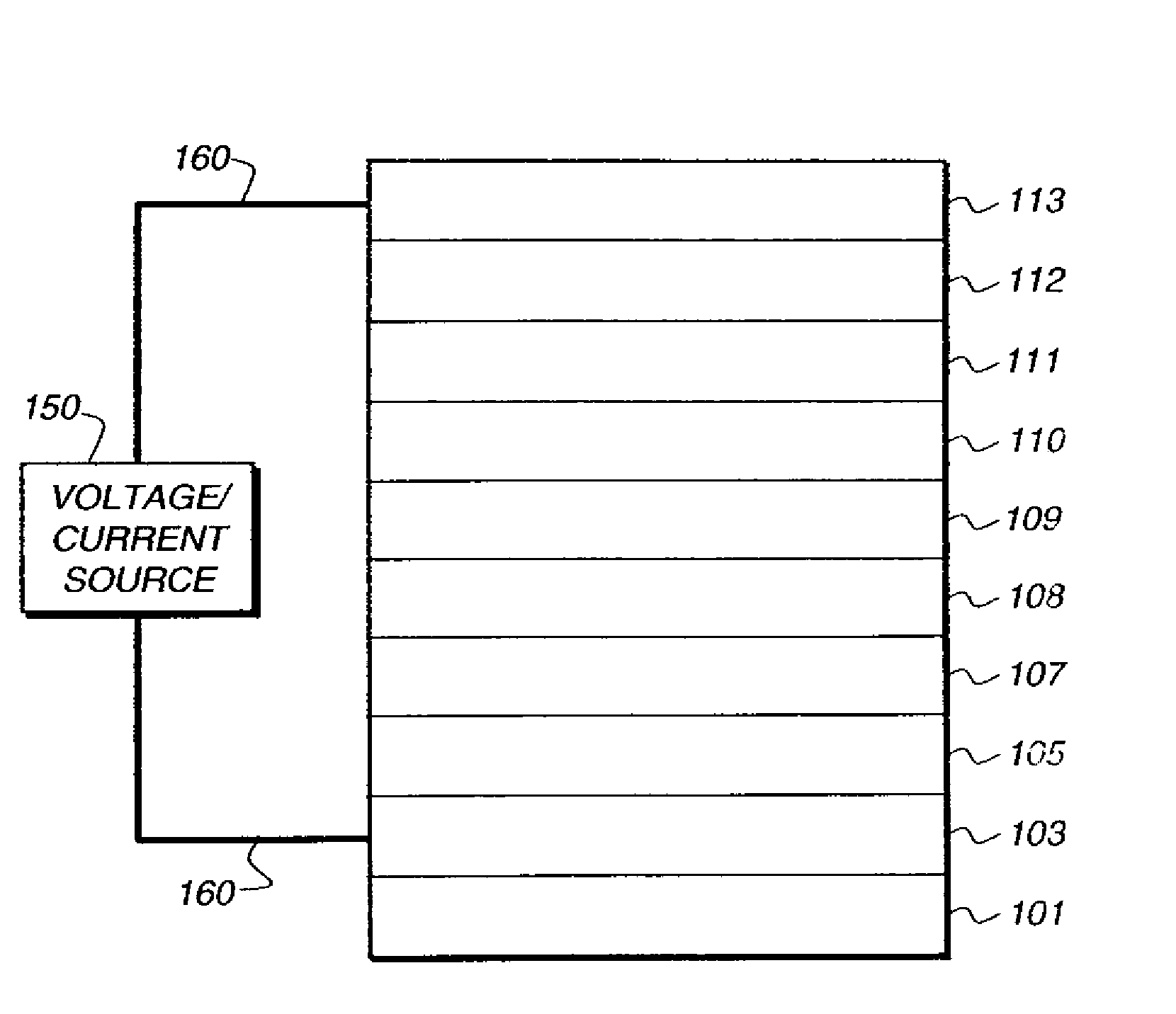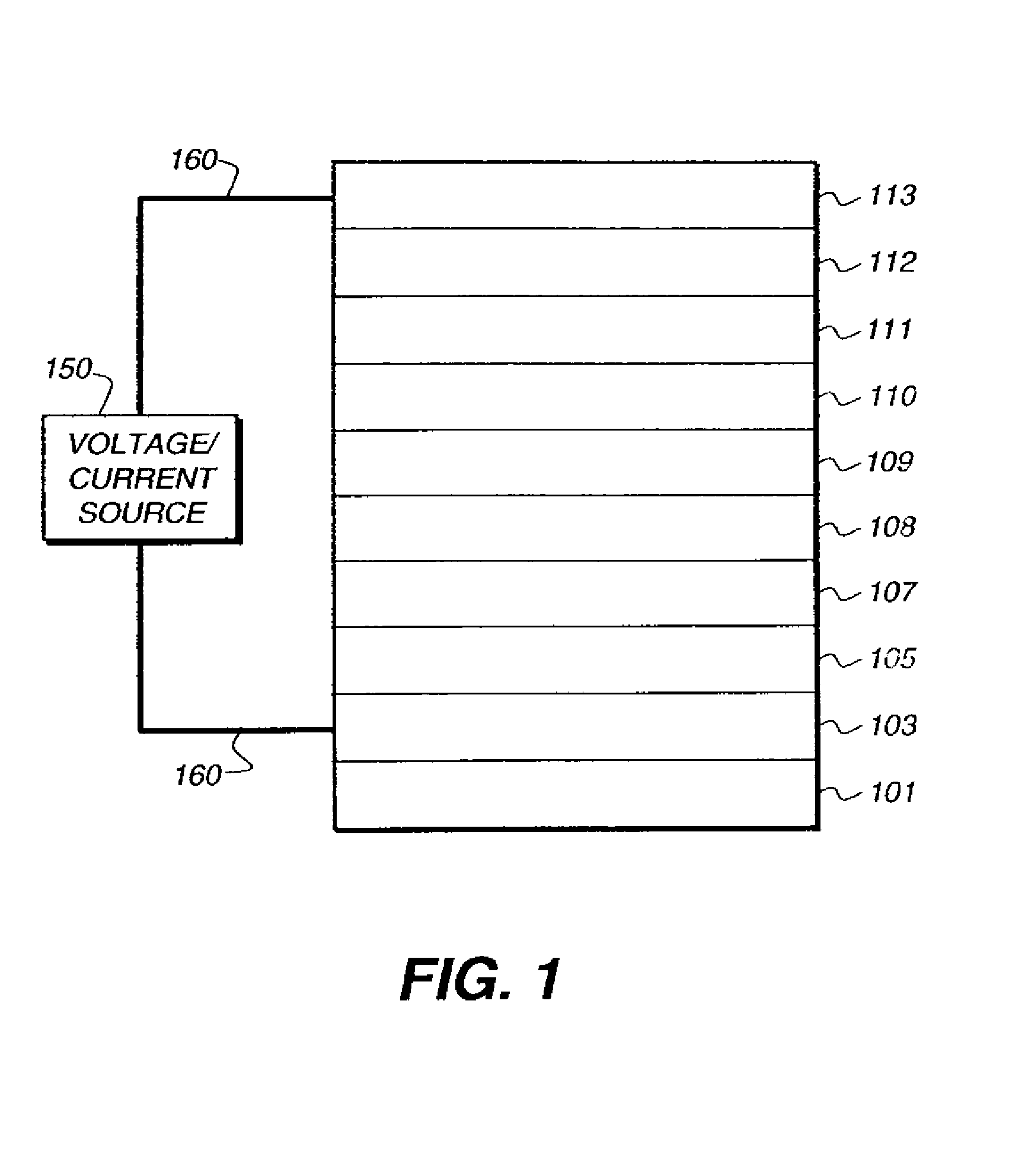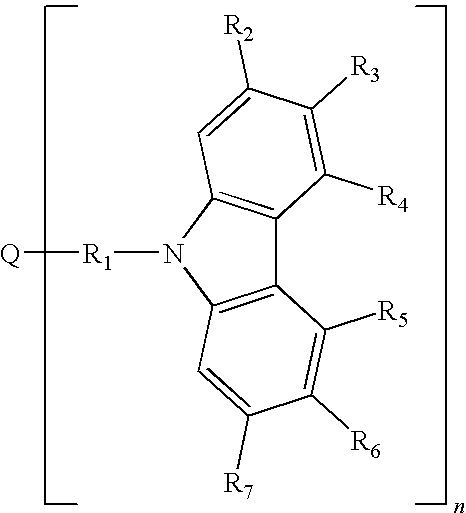Electroluminescent devices including organic eil layer
a technology of electroluminescent devices and electron injection layers, which is applied in the direction of thermoelectric device junction materials, semiconductor devices, electrical apparatus, etc., can solve the problems of large efficiency loss, performance limitations, and many desirable applications, and achieve improved electroluminescent features, reduced operational voltage, and high luminous efficiency
- Summary
- Abstract
- Description
- Claims
- Application Information
AI Technical Summary
Benefits of technology
Problems solved by technology
Method used
Image
Examples
examples
[0321]The invention and its advantages can be better appreciated by the following examples.
Device Examples 1-1 Through 1-6
[0322]An EL device (Device 1-1) was constructed in the following manner:[0323]1. A glass substrate, coated with an approximately 25 nm layer of indium-tin oxide (ITO) as the anode, was sequentially ultrasonicated in a commercial detergent, rinsed in deionized water, degreased in toluene vapor and exposed to an oxygen plasma for about 1 minute.[0324]2. Over the ITO a 1 nm fluorocarbon (CFx) hole injecting layer (HIL) was deposited by plasma-assisted deposition of CHF3 as described in U.S. Pat. No. 6,208,075.[0325]3. Next, a hole transporting layer (HTL) of N,N′-di-1-naphthyl-N,N′-diphenyl-4,4′-diaminobiphenyl (NPB) was vacuum deposited to a thickness of 75 nm.[0326]4. An exciton / electron blocking layer (EBL) of 4,4′,4″-tris(carbazolyl)-triphenylamine (TCTA) was vacuum deposited to a thickness of 10 nm.[0327]5. A 35 nm light emitting layer (LEL) consisting of a mix...
example series 15-1 and 15-2
Device Example Series 15-1 and 15-2
[0426]Orange-emitting phosphorescent EL devices 15-1 to 15-2 were constructed using vapor deposition techniques in the following sequence:[0427]1. A glass substrate coated with a 57 nm layer of indium-tin oxide (ITO) as the anode was sequentially ultrasonicated in a commercial detergent, rinsed in deionized water, dried, and heated at 130° C. about 12 hours.[0428]2. A 10 nm thick hole-injection layer (HIL) of a hole-injecting material DQHC was then deposited.[0429]3. A 70 nm hole transport layer (HTL1) of NPB was then deposited onto HIL.[0430]4. A 40 nm light emitting layer comprising consisting of a mixture of INV-1 as the electron transporting co-host, PHF-19 as the hole transporting (HT) co-host, PD-19 as a yellow phosphorescent emitter and PD-20 as a red phosphorescent emitter was then vacuum deposited onto the HTL. The PHF-19 comprises 15 wt. % of the total of the co-host materials in the LEL, the PD-19 comprises 18 wt. % and the PD-20 compris...
example series 16-1 and 16-2
Device Example Series 16-1 and 16-2
[0437]White tandem EL devices 16-1 to 16-2 were constructed using vapor deposition techniques in the following sequence:[0438]1. A glass substrate coated with a 57 nm layer of indium-tin oxide (ITO) as the anode was sequentially ultrasonicated in a commercial detergent, rinsed in deionized water, dried and heated at 130° C. about 12 hours.[0439]2. A 10 nm thick hole-injection layer (HIL) of a hole-injecting material DQHC was then deposited.[0440]3. A 150 nm hole transport layer (HTL1) of NPB was then deposited onto HIL.[0441]4. A 30 nm thick blue light-emitting layer (BLEL) comprising the host material 9-(1-naphthyl)-10-(2-naphthyl)anthracene (NNA) and 5.0% of blue-emitting fluorescent material BD-1 was then deposited.
[0442]5. A 10 nm thick hole blocking layer (HBL1) of Inv-24 was then deposited.[0443]6. A 30 nm thick n-doped electron transporting layer (ETL1) consisting of a mixture of 49% LiQ, 49% Bphen, and 1% metal Li was then deposited.[0444]7...
PUM
 Login to View More
Login to View More Abstract
Description
Claims
Application Information
 Login to View More
Login to View More - R&D
- Intellectual Property
- Life Sciences
- Materials
- Tech Scout
- Unparalleled Data Quality
- Higher Quality Content
- 60% Fewer Hallucinations
Browse by: Latest US Patents, China's latest patents, Technical Efficacy Thesaurus, Application Domain, Technology Topic, Popular Technical Reports.
© 2025 PatSnap. All rights reserved.Legal|Privacy policy|Modern Slavery Act Transparency Statement|Sitemap|About US| Contact US: help@patsnap.com



